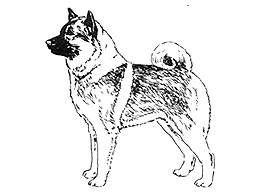Norwegian Elkhound Breed Standard
Last updated: 23 Jan 2015
A breed standard is the guideline which describes the ideal characteristics, temperament, and appearance of a breed and ensures that the breed is fit for function with soundness essential. Breeders and judges should at all times be mindful of features which could be detrimental in any way to the health, welfare or soundness of this breed.

Kennel Club, London 1994
Name Amended in Australia May 1994
-
Group:
Group 4 (Hounds)
-
History:
-
General Appearance:
Powerful; compact body; square outline and proud carriage; coat close and abundant but not open; upstanding pointed ears; tail tightly curled over back.
-
Characteristics:
A hardy hunting Spitz with a bold energetic disposition.
-
Temperament:
Friendly, intelligent and independent without any sign of nervousness.
-
Head And Skull:
Wedge shaped, comparatively broad between ears; stop, not large; forehead and back of head slightly arched; foreface broad at root (not pinched in), evenly tapering whether seen from above or side, never pointed; bridge of nose straight and approximately the length of forehead; tight fitting skin on head, no wrinkle.
-
Eyes:
Not prominent, slightly oval, medium size, dark brown, giving frank, fearless and friendly expression.
-
Ears:
Set high, small, firm and erect, pointed and very mobile; slightly taller than width at base; when alert, outer edge should be vertical.
-
Mouth:
Jaws strong with perfect, regular and complete scissor bite, i.e. the upper teeth closely overlapping the lower teeth and set square to the jaws.
-
Neck:
Medium length, powerful, carrying the head high; a rich ruff on close fitting skin but no dewlap.
-
Forequarters:
Legs straight with good, not coarse, bone and strong pasterns; shoulders sloping; elbows closely set in.
-
Body:
Powerful; short, strong back; loin short and wide with very little tuck-up; chest deep and broad; well curved ribs; topline straight and level; distance from brisket to ground not less than half the height at withers.
-
Hindquarters:
Legs firm, strong and powerful; little but definite bend at stifle and hock; straight when viewed from behind.
-
Feet:
Comparatively small, slightly oval; tightly closed, well arched toes with protective hair between thick pads; turning neither in nor out. Nails firm and strong.
-
Tail:
Strong, set on high; thickly coated without plume; tightly curled, preferably over the centre line of back.
-
Gait/Movement:
Demonstrates agility and endurance; stride at the trot even and effortless, back remaining level; as speed of trot increased, front and rear legs converge equally in straight lines towards a centre line beneath body.
-
Coat:
Close, abundant, weather resistant; soft, dense, woolly undercoat and coarse, straight outer coat; short and smooth on head and front of legs, slightly longer on back of front legs, longest on neck, back of thighs and tail; not trimmed.
-
Colour:
Grey of various shades, with black tips to out coat; lighter on chest, stomach, legs, underside of tail, buttocks and in a harness mark; ears and foreface dark; a dark line from eye to ear desirable; undercoat pure pale grey. Any pronounced variation from the grey colour, sooty colour on lower legs, spectacles or white markings undesirable.
-
Sizes:
Ideal height:
Dogs 52 cm (20.5 ins) at shoulder
Bitches 49 cm (19.5 ins) at shoulder
Weight:
Dogs approx. 23 kg (51 lbs)
Bitches approx. 20 kg (44 lbs)
-
Faults:
Any departure from the foregoing points should be considered a fault and the seriousness with which the fault should be regarded should be in exact proportion to its degree and its effect upon the health and welfare of the dog.
-
Notes:
Male animals should have two apparently normal testicles fully descended into the scrotum.
 For owners
For owners
 Members
Members
 Dogs Australia is a not-for-profit organisation advocating for the preservation of purebred dogs through ethical breeding.
It champions the highest standard of animal welfare through education and fostering dog-loving communities.
Internationally recognised and established in 1958 as the Australian National Kennel Council (ANKC),
the organisation promotes responsible dog ownership; maintains the ORCHID* heritable canine diseases database;
funds research into canine diseases; and supports state and territory-based member bodies.
Dogs Australia promotes breed conformation shows and community sports for dogs that fulfil a breed’s natural instincts.
Dogs Australia is a not-for-profit organisation advocating for the preservation of purebred dogs through ethical breeding.
It champions the highest standard of animal welfare through education and fostering dog-loving communities.
Internationally recognised and established in 1958 as the Australian National Kennel Council (ANKC),
the organisation promotes responsible dog ownership; maintains the ORCHID* heritable canine diseases database;
funds research into canine diseases; and supports state and territory-based member bodies.
Dogs Australia promotes breed conformation shows and community sports for dogs that fulfil a breed’s natural instincts.







